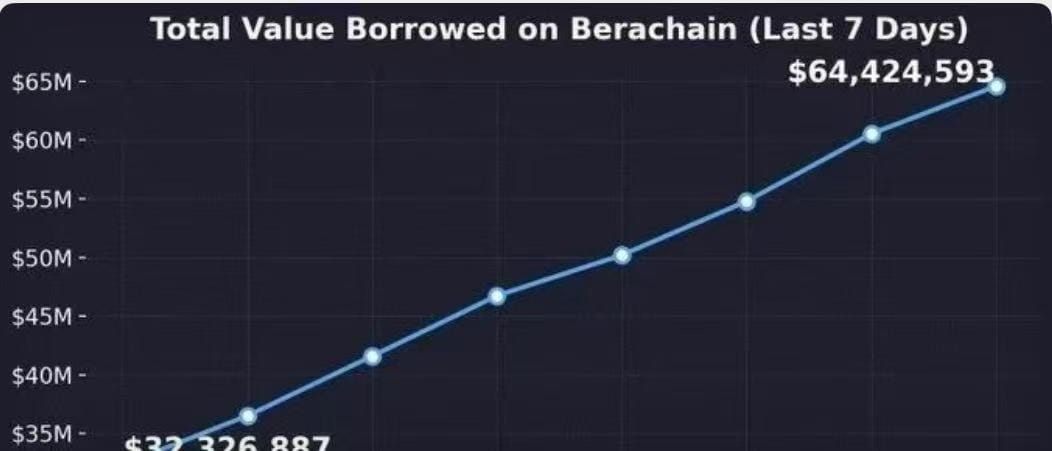The cryptocurrency market is never short of surge myths, but behind each myth often lies a deep narrative of ecological evolution and capital logic.
Dolomite, as the lending leader of the Berachain ecosystem, has seen its token DOLO achieve nearly tenfold growth within two months, seemingly repeating such a story — but it is not just the success of an individual token; it may signal the explosion of the entire public chain ecosystem.
Behind this signal is Berachain's unique PoL (Proof of Liquidity) consensus mechanism and its latest upgraded version PoL v2 making a comprehensive effort.
DOLO Explosion | Dual Drive of Ecological Collaboration and External Narrative
From a product perspective, Dolomite is not just another Aave clone. It redefines the lending experience through mechanisms like virtual liquidity and dynamic collateral, allowing users to engage in leveraged trading and yield farming while lending assets, truly achieving 'capital without sleep'. This innovation aligns perfectly with Berachain's unique PoL consensus mechanism — users can deposit assets for both lending and participate in validating the network to receive multiple incentives. This 'one fish, multiple eats' model has become key to attracting early users and funds.
But what truly heated up market sentiment quickly was the potential collaboration between Dolomite and the Trump family-backed project World Liberty Financial (WLFI). Although not officially announced yet, various clues indicate that the two sides have begun deep binding at the technical, asset integration, and even political resource levels. The stablecoin USD1 that WLFI plans to launch is expected to connect to the Dolomite lending system, bringing new traffic and asset types. More importantly, the influence behind Trump may bring a breakout effect to this DeFi protocol and even the entire Berachain.

PoL v1: A Liquidity-Driven Consensus Revolution
Berachain's PoL mechanism has been fundamentally different from traditional PoS chains since its inception. Its core logic is: those who can bring more liquidity will receive more network rewards and influence. This mechanism is realized through three core roles (validators, protocols, liquidity providers) and two core assets (BGT and BERA):
BGT serves as the central governance and incentive distribution token, distributed to validators through inflationary issuance;
Protocols need to 'bribe' validators (offering stablecoins, protocol tokens, etc.) to compete for BGT incentives;
Validators distribute BGT based on the bribe value provided by the protocol, forming a liquidity competition market;
Liquidity providers (LPs) can earn additional BGT incentives on top of the base returns when supporting the protocol.
This mechanism has formed a powerful positive feedback loop: the protocol continuously optimizes LP returns to enhance competitiveness → attracts more liquidity → validators receive more bribes → the network becomes more secure, incentives become richer → the ecosystem enters a growth flywheel.
However, PoL v1 also has a clear shortcoming: BERA's role in the economic cycle is weak. As a gas token and staking asset, BERA lacks native yield scenarios; users find it hard to benefit from holding BERA unless they engage in complex LP mining. This not only limits capital efficiency but also hinders institutional funds' participation.
PoL v2 | BERA Becomes a Key Upgrade for Real Yield Assets
The launch of PoL v2 aims to address the shortcomings of v1, upgrading BERA from a 'network cost token' to an 'on-chain yield certificate'. The core changes are:

Introducing native BERA staking rewards:
Users can directly stake BERA or WBERA on Berahub to receive the certificate token sWBERA (similar to Lido's stETH), which can continue to be used in ecosystem DeFi for multiple uses of capital.
Yield Source Transformation:
Of the protocol bribes received by validators in the PoL mechanism, 33% will be used to repurchase WBERA and distributed proportionally to BERA stakers. This means that yields no longer rely solely on pure inflation but are derived from real protocol income.
Dual Improvement of Capital Efficiency and Compliance:
sWBERA can serve as LST to recapture yields within the ecosystem, enhancing capital utilization.
Yield sources are clear and auditable, meeting institutional and regulatory requirements.
The current annualized yield on on-chain staking is as high as about 103%, significantly higher than CEX earning products (60%-90%).
Institutional-level Yield Tools: The Profound Significance of PoL v2
PoL v2 is not only an optimization of the economic model but also a key step for Berachain towards an institutional-level market.
Real Yield Narrative: The yield of BERA comes from real expenditures of the protocol rather than inflation, which aligns closely with the recent advocacy in the US (Clarity Act) that 'yields should be linked to real economic behavior', paving the way for compliance.
Structured Product Potential: sWBERA can be packaged as on-chain bonds, wealth management tools, and other structured products, attracting traditional capital.
Ecological Positive Feedback Strengthening: More BERA staking → network becomes more secure → protocols become more willing to bribe validators → BERA yields increase → attract more staking, forming an enhanced flywheel.
Ecological Collaboration: The Resonance Effect of DOLO and PoL v2
The surge of DOLO and the release of PoL v2 are not isolated events, but rather a typical embodiment of the collaborative development of the Berachain ecosystem.
Dolomite serves as the core of lending, providing basic liquidity for the ecosystem;
PoL v2 injects yield attributes into BERA, enhancing capital efficiency;
External collaborations such as WLFI bring breakout traffic and asset types;
BECTRA upgrades improve on-chain performance and reduce transaction costs.
This multi-layered, multi-directional cooperation has propelled Berachain from a 'technical experiment' to an 'economic system', replicating the DeFi explosion path of early Solana or Ethereum.
The explosion of Berachain is just the beginning
The tenfold performance of DOLO is not only a release of market sentiment but also a sign of ecological maturity. The introduction of PoL v2 further strengthens Berachain's dual identity as a 'liquidity engine' and 'yield infrastructure'.
With more protocols going live, WLFI bringing traditional circle attention, and PoL v2 promoting institutional capital entry, Berachain may be迎来 its 'DeFi Summer 2.0'. For investors, understanding DOLO and PoL v2 may be the key to understanding the future of the Berachain ecosystem.
It is worth mentioning that Berachain is still in its early stages, with most projects yet to issue tokens. The success of DOLO is just the beginning; whether it can continue to lead the ecological explosion in the future will depend on observing more protocol economic model designs and external cooperative implementations. But there is no doubt that Berachain has already shown the potential to become the next generation of public chain leader.





